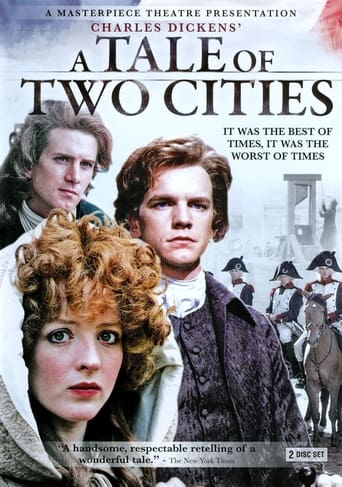

I think the commenter from Florida may be discussing the awful film made for television in the early '80s. This mini-series made in 1989 does not have no-name B-list actors. They are all superb British and French actors. I would just caution people that they need to be aware which version they have gotten hold of to watch. The costuming is they only thing that seems a little out of place in this version. As to highlights of this version, I would have to say that James Wilby as Sidney Carton does excellent work. He is actually heartbreaking to watch. It is easy to make this pivotal character much too maudlin, but this is not the case here.
... View MoreI thought this movie was horrible! The acting and directing was something that a four year old could do. I DID NOT like the way the movie was cast and the things they changed from the original book. First of all, Carton and Darnay looked NOTHING alike. Lucie was NOTHING how they described her in the book. Not to mention how horrible the actress was who played Madame Defarge. Not only was the acting terrible, but the directing and blocking was horrible too. But, I'd have to say the worst part was when Carton and the seamstress started making out randomly while they were at the Guillitine. I mean, come ON! You have got to be kidding me! This movie is probably one of the worst movies I've ever seen. I would not refer anyone to this movie.
... View MoreI saw this in English class, and I must say, is an engrossing adaptation of the book. It kept me involved and i liked the little changes they made to the movie. A must watch for any fan of Charles Dickens' novels.Although I did not care for the way Lucie's hair looked in the beginning, it is just a minor quibble. The two men playing Darnay and and Carton are perfect for the roles, and Jerry Cruncher is hilarious. Another thing I liked was that they made Madame Defarge young and witch looking. in the novel she is only in her twenties when Lucie finds her father, and less then 20 years have passed, so she is quite young.All in all 9 out of 10 stars.
... View MoreI rented this movie without expectation, thinking it was just another mini series made in the 80's with poor lighting and wacky hairstyles. But I was blown away by it! The innocence and heartbreaking bittersweetness of the movie gripped me, and of the thousands of movies I've watched I have never seen one with this astounding of character development. Even if you generally don't enjoy movies like this, I recommend to give it a try! It's not easily found, but if you are lucky enough to stumble across it you'll love it. The set and hairstyles are very 80's-ish, but the acting and characters are so perfectly drawn I didn't notice anything but them! Sydney Carton now ranks right up there with Sir Percy Blakeney (from The Scarlet Pimpernel) on my list of ideal men.
... View More